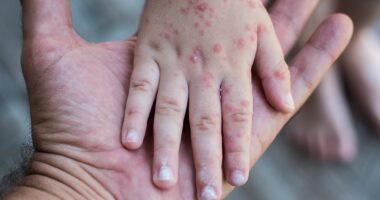A taboo health problem is quietly brewing among America’s elderly population.
They are having casual, unprotected sex at record levels, leading to historic rates of sexually transmitted diseases (STDs).
Chlamydia diagnoses in people over 65 years old have more than tripled since 2010, while gonorrhea cases multiplied about six-fold and syphilis cases surged nearly ten-fold.
As DailyMail.com’s maps show, the problem does not appear to be driven by geography – rural Alaska and California, the country’s most populous state, score among the highest for common STDs.
And it doesn’t appear to be political either – deep red South Dakota and ultra blue Washington, DC both also have high rates of the diseases.
Public health experts posit that STDs are increasing among older Americans due to a lack of knowledge about them and their symptoms and, behaviors that put them at risk.
Many older Americans also grew up without comprehensive sex education in schools, which focused primarily on promoting abstinence until marriage.
But over the past decade, a new sexual revolution in aging has occurred, upending norms and morality of casual sex.
Once women have transitioned out of menopause the fear of an accidental pregnancy goes out the window. And with such little education about the risk factors for and ways to prevent STDs, the use of condoms plummets.
The vast majority of older adults who engage in sexual activity therefore do so without using condoms.
A study by the AARP found only eight percent of sexually active seniors reported using them all the time, while another put that rate closer to three percent.
Janie Steckenrider, an expert in aging and sexuality at Loyola Marymount University in Los Angeles, said in the Lancet: ‘Given the past and current sexual experiences of this generation of older adults, their sexual risks should come as no surprise.
‘This generation rarely considers using protection because they came of age at a time when sex education in school did not exist, HIV was virtually unheard of, and their main concern in seeking protection was to avoid pregnancy.’
Across the country, South Dakota led the way in adults 65 and over being diagnosed with syphilis in 2022, the most recent year for which data is available, with more than six cases for every 100,000 people 65 and older, according to federal data.
Syphilis among all ages is on the rise nationwide, increasing nearly 80 percent over the past five years, and the surge is worrying public health officials, as the disease can advance to damage the brain, nerves, eyes, and heart if it goes untreated.
Symptoms begin with small open sores on the genitals, mouth, or rectum, as well as enlarged lymph nodes.
In the second stage, a skin rash develops, as well as genitals sores, fever, muscle and joint pain, vision changes, and loss of appetite.
When the infection advances further, it can inflame and damage heart valves and slowly degrade the brain, causing personality changes, memory loss, difficulty making decisions, and strokes.
Washington, DC, led the way in gonorrhea diagnoses, with roughly 29 cases per 100,000 people and Alaska recorded the highest rate of chlamydia in seniors at nearly 18 cases per capita.
From just 2018 to 2022, Chlamydia rates in seniors rose from about one per 100,000 people to approximately two per 100,000 people, a 125 percent increase.
Behind Alaska at the top spot, Washington, DC, had the second-highest per capita rate of chlamydia among people over 65 – 16 per 100,000 people – followed by California, with 11.5 cases per capita.
In Alaska, public health officials have linked ballooning STD rates with overall difficulty accessing preventive care.

Chlamydia diagnoses more than tripled between 2010 and 2023 while gonorrhea cases multiplied about six-fold in adults 65 and older. Syphilis cases increased nearly ten-fold
The state is massive and largely remote, with cities and villages dotted throughout, though not connected by roads. Many are only accessible by air or boat, and getting to a doctor for a checkup can be all but impossible.
In Washington, DC, meanwhile, drug use, poverty, and unstable housing reduce access to preventive sexual healthcare.
Gonorrhea rates in seniors have also spiked, from 1.3 per capita in 2010 to three in 2016 and as high as six per capita in 2022.
The rate of gonorrhea cases was highest in DC, at about 30 per 100,000 seniors, followed by Alaska with 15 cases and New Mexico with 11 cases per capita.
The rate of syphilis in seniors has reached its highest point in about two decades, from just 0.1 cases per 100,000 people in 2003 to nearly two cases per capita in 2022.
South Dakota, an overall rural state where people have less access to preventive care such as health screenings, education, condoms, and vaccinations, led the nation in senior syphilis cases with more than six cases per capita, followed by Delaware with 5.7 cases per capita.
In third place came New Mexico, which had five cases per capita, followed by DC, which had 4.6 cases per 100,000 seniors.
Seniors are more likely to live in congregate settings than younger Americans, such as senior communities, assisted living facilities, and nursing homes, and elder care advocates have identified the growing rates of STDs in nursing homes over the past 20 years, though estimates are hard to come by given that rates are typically tracked by age group rather than where people live.
Reports of sexual abuse in nursing homes by residents against fellow residents, including forced nonconsensual sex, are not uncommon yet often underreported.
Sexual education in US schools has changed considerably over the past century, and thousands of people born in the 1930s, 40s and 50s received a vastly different education, which put an emphasis on the dangers and moral consequences of having sex before marriage, and not safe sex methods or STDs.
In the 1960s, students were taught about sex by studying animal reproduction and plants, though instructors generally stopped short of talking about human sexuality.
Young men were told to steer clear of ‘loose’ women to avoid venereal disease, while women were taught the importance of ‘chastity’ and ‘purity.’
This has spawned a generation-wide reluctance for openly discussing sex, asking partners about their preferences in the bedroom, and inquiring whether they have had a recent STD test.
Researchers from various US universities surveyed four dozen adults aged 65 to 94 using a 27-item sexual health knowledge questionnaire.
On average, they answered just 11 out of 27 questions correctly. More than half believed the human papillomavirus (HPV) – a group of viruses that can cause warts and even cancers – could cause HIV, didn’t know there were vaccines for gonorrhea and chlamydia, and mistakenly thought frequent urinary infections caused chlamydia.
Dr Mark Gold, a psychiatrist and researcher based in Florida, wrote in Psychology Today: ‘Many older people think the only reason for condoms is preventing pregnancy.
‘Physicians routinely ask young people about their sexual history and screen for STIs and should do the same for older adults.’
Rates could also be rising because people are living longer and are generally healthier than older generations have been in their senior years.
Public health trackers have also drawn a connection to the rise of the little blue pill, Viagra, which revived men’s libidos across the globe.
There is also a growing selection of dating apps geared at helping seniors meet other seniors, including OurTime and SeniorMatch.
Partners who meet this way are typically unaware of each other’s sexual health history, putting both, as well as future partners, at risk of infections.










